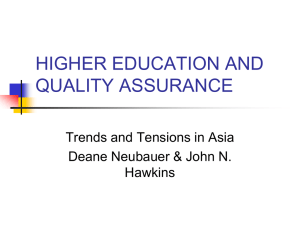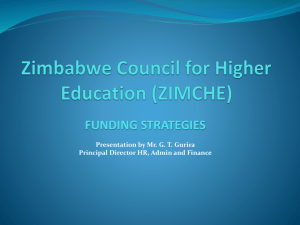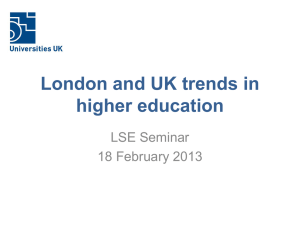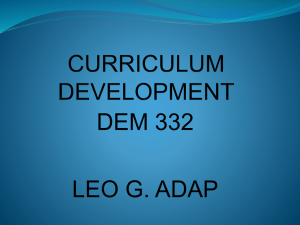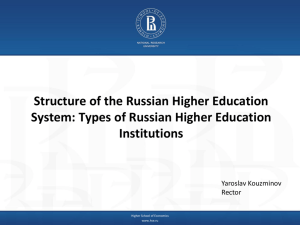Philippine Higher Education Institutions and World Rankings
advertisement
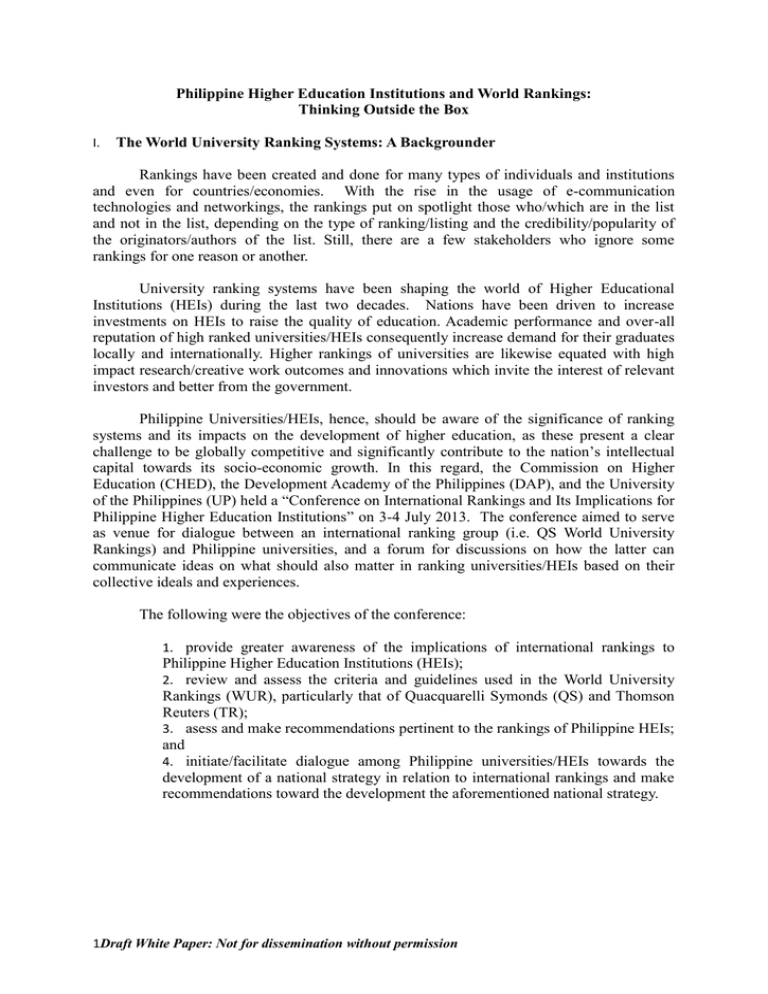
Philippine Higher Education Institutions and World Rankings: Thinking Outside the Box I. The World University Ranking Systems: A Backgrounder Rankings have been created and done for many types of individuals and institutions and even for countries/economies. With the rise in the usage of e-communication technologies and networkings, the rankings put on spotlight those who/which are in the list and not in the list, depending on the type of ranking/listing and the credibility/popularity of the originators/authors of the list. Still, there are a few stakeholders who ignore some rankings for one reason or another. University ranking systems have been shaping the world of Higher Educational Institutions (HEIs) during the last two decades. Nations have been driven to increase investments on HEIs to raise the quality of education. Academic performance and over-all reputation of high ranked universities/HEIs consequently increase demand for their graduates locally and internationally. Higher rankings of universities are likewise equated with high impact research/creative work outcomes and innovations which invite the interest of relevant investors and better from the government. Philippine Universities/HEIs, hence, should be aware of the significance of ranking systems and its impacts on the development of higher education, as these present a clear challenge to be globally competitive and significantly contribute to the nation’s intellectual capital towards its socio-economic growth. In this regard, the Commission on Higher Education (CHED), the Development Academy of the Philippines (DAP), and the University of the Philippines (UP) held a “Conference on International Rankings and Its Implications for Philippine Higher Education Institutions” on 3-4 July 2013. The conference aimed to serve as venue for dialogue between an international ranking group (i.e. QS World University Rankings) and Philippine universities, and a forum for discussions on how the latter can communicate ideas on what should also matter in ranking universities/HEIs based on their collective ideals and experiences. The following were the objectives of the conference: 1. provide greater awareness of the implications of international rankings to Philippine Higher Education Institutions (HEIs); 2. review and assess the criteria and guidelines used in the World University Rankings (WUR), particularly that of Quacquarelli Symonds (QS) and Thomson Reuters (TR); 3. asess and make recommendations pertinent to the rankings of Philippine HEIs; and 4. initiate/facilitate dialogue among Philippine universities/HEIs towards the development of a national strategy in relation to international rankings and make recommendations toward the development the aforementioned national strategy. 1Draft White Paper: Not for dissemination without permission I. Workshop Results A. On the Criteria, Relevance, Context of World University Rankings The workshop participants (who were grouped into 5 with about 20 members each) generally expressed the belief that the University Ranking Systems (QS and TR) are relevant and criteria used are proxies for internationalization. The Ranking Systems have been viewed by the participants as unavoidably significant, an incentive for improvement and a tool for recognition. Hence, Philippine universities should be encouraged/ should participate in these systems. There were however philosophical underpinnings that were voiced out by some ‘participants’ like, the system seem to be a “homogenization” and should consider economic inequalities among universities/HEIs from different countries/regions which are in various stages of development, not to mention cultural diversity amongst these countries. For example, the higher education landscape in the Philippines could be considered different even from the rest Asia considering its socio-culturalk diversity primarily influenced by the variety of influence from its neighbors by virtue of its geographic location and archipelagic nature. “Academic Reputation” which is based heavily on research outputs/impacts (publication, innovation and citation) could not be hurdled by most Philippines HEIs except those that could “afford” to undertake research. Academic loading in most HEIs in the country are based mainly on teaching with research being undertaken by a few faculty i.e. from 1% to 10% in the faculty. Research funds are limited and facilities not at par with the requirements of the field; hence, outputs are quite few and some are not publishable. From the arts and humanities group, there was the opinion that in the ranking system, creative productivity seemed to be not appropriately and adequately nuanced and could be missed out but this is significant in shaping knowledge generation and dissemination in HEIs. Student-faculty ratio being used as a metric for academic reputation in the world rankings does not capture quality education completely. It is not reflective of the HEIs performance indicators. Faculty/student interactions should produce student competencies that could not be shown by ratios. Extension programs are not explicitly considered in the metrics of the ranking systems but are being undertaken by most universities/HEIs in the Philippines. These are not income generating but contribute to the development of the country specifically in the rural areas, although it can be argued that this could be considered under “research impact”. “Graduate employability” seems to be improperly quantified for the Philippines, considering that a good percentage of graduates from Philippines HEI have been employed by leading government and non-government agencies and organization outside of the country and, in fact contributing to the development of the countries wherein they are employed. The systems world rating/criteria are proxies of internationalization of the universities. In the Philippines, many HEIs find it difficult to reconcile “nationalism” with “internationalism”, and therefore subsequently internalizing and operationalizing “internationalization” and globalization within its system. Finally, it was the opinion of some participants that the US and European universities have been apparently the benchmark for excellence the systems should capture realities worldwide in the internationalization process in this rapidly changing world. 2Draft White Paper: Not for dissemination without permission SWOT Analysis and Internationalization/University Ranking B. Suggested Strategies for Strengths and Opportunities Philippine universities/HEIs are considered with creative, resourceful, innovative and resilient human resource (faculty, researchers, staff and students), in almost all the fields. The graduates are employable locally and in some fields globally competitive. The national environment is highly diversified and rich in research topics. The same goes for the culture and heritage. Proficiency in English by all sectors in the academe (and the society) is one very strong asset in this globalization wave where “English” is the medium for communication. Opportunities are wide and open with ASEAN integration and other networkings regionally and globally; more funding opportunities locally are now being joined. Weaknesses and Threats Low percentage of faculty with Ph.D. in many universities/HEIs is considered a weakness for this means lack of expertise in both research and teaching. Fast turnover rate of faculty (particularly those with Ph.D.) due to low salary and lack of other incentives, is still a major problem for a number of HEIs especially those that are government-funded/not income generating. Low productivity in research and creative work is limited by teaching overload in most universities/HEIs, worsened by lack of facilities and funds. In other HEIs perception that research is difficult needs to be tackled by the administration/leadership where motivation and enabling environment are most needed. Replication of specializations between many HEIs and even in sub-units of universities is one weakness because funds could not be optimized or focused. Salaries and incentive package for academics and staff are considered weaknesses and threats because locals tend to go to greener pastures i.e. abroad to gain more economically. Enabling laws and policies are still lacking to enhance research/creative activities locally and undertake academic linkages and collaborations globally. Faculty and student inward and outward mobility lack government legislation and support from relevant agencies. Basically, although the country has gained a hit of popularity for tourism with the “Its More Fun in the Philippines” advertisement, students and faculty from abroad are still wary of the Philippines because of its peace and order image. Further, many universities cannot offer “decent” and sufficient accommodation, housing for incoming faculty/experts and students. Mismatch of Philippine academic year with the rest of the region/world is one set back because it can cause delays for outbound and even inbound, students and faculty; and many other related efforts. Finally, “too open”, “too hospitable” “too subservient” attitudes/values common to Filipinos could be a weakness in the attempt to become internationalized according to some participants. 3Draft White Paper: Not for dissemination without permission C. Recommendations/Strategies towards Internationalization The participants agree that a “National Higher Education R&D and Internationalization Strategy/Agenda should be developed and implemented the soonest. The strategy is to have priority inter-university researches through partnerships locally (and internationally) with funds coming from various sources. Niches for research (and teaching) should be considered in this partnerships including thrusts of the national government and if relevant those of international funding agencies. For enhanced participation of qualified (which is quite few) faculty/researcher, incentives should be packaged for these multitransdisciplinary research/creative works. Legislation/s specific to research and the implementation of the proposed HEI R&D and Internationalization Strategy/Agenda should be made for its successful implementation. Monitoring of productivity in terms of publications, and Ph.D. graduates etc. should be closely done and be the basis for further reward system. Upgrade of key research centers and their satellites should be implemented wherein focused utilization of funds could become beneficial to a greater number of institutions compared to giving insufficient enhancement to several/many institutes. Key plantilla positions for research/creative works should be supported in HEIs. A well-planned faculty development which includes Ph.D. fellowships and recruitment should have research/creative productivity as a primary indicator. Foreign faculty should be considered in areas where their expertise are needed; mentors for research and teaching could be availed of through co-programs sandwich programs with high ranking university. Teaching underloading and retooling of faculty could help them engage in productive, research and creative activities. Curricular programs should be research and creative work based, internationalized and demands locally/globally systematically considered. Benchmarking of curricular offerings with the best universities result to enhanced academic quality and improved changes of international academic collaboration; International Quality Assurance should be done periodically on these offerings; being research/creative work based-publications/ other universally-cited and “measurable” outputs can be required for graduation. Universities should strive to seek double degrees and sandwich programs with high ranked universities taking into consideration all types of costs and benefits in the process, and CHED could help HEIs to be more strategic in this regard. A Philippine version of quality accreditations could be developed/used as an additional option but not disregarding the international quality assurance standards. Universities/HEIs should improve admission requirements particularly with the K-12 curricula, students could be screened well as to qualities of successfully completing their degrees are their employability. CHED could help in the development of “Graduate Tracer Strategies” locally and in the region, with achievements documented made available and serve as icons to students/where they have graduated, and the country in general. Suggestions to the Commission on Higher Education (CHED), Department of Education (DEPED) and Other Rlevant Agencies Consideration of the following was suggested. School/Academic calendar should be aligned with the rest of the world; Institutional/fiscal autonomy for State Universities and Colleges (SUCs) to generate income from R&D; 1. 2. 4Draft White Paper: Not for dissemination without permission Varying tiers of support for different HEIs to develop research and internationalization; 4. Harmonize and rationalize HEIs according to World University Rankings vis-a-vis national setting; 5. Institutionalize systematic relationship between academic and industry/stakeholders for better partnership; 6. Require graduate programs have research/creative work and publications/outputs as requirements for graduation; 7. With the ASEAN integration coming closer at 2015, HEIs should be aware of its relative position and “coping mechanisms” put in place; and 8. Legislative and Executive Agencies have enabling laws, policies and mechanisms for internationalization, and mobility of faculty and students. 3. I. Conclusions and Lessons from other Countries Building global universities/HEIs in the context of developing versus developed world could really pose several difficult challenges and decisions would entail economic and socio-political considerations. Even within a university there could be problems of operationalizing “nationalism” with “internationalism”. A strong leadership, appropriate strategies and indicators and rewards have been the formula for some success stories in Asia. Vice-President Bajpai, President of the Association of Indian Universities, the world’s largest network of university, reports (2013) that India was at first adverse to opening up to internationalization with the feeling of some sectors that the “interests of India will not be protected”. Eventually it was decided that “with appropriate legislation, ‘floodgates’ can be opened and India can enlist help of foreign universities to increase academic capacity and provide competition that can spur greater quality in local institutions”. Indonesia, according to Prof. Suharchiyanto of Bogor University, included in its “2010 Master Plan for Economy” new targets for its universities, considering the improvements in education that could spark exponential growth in Indonesia’s economy. The government has set aside 1% of its Gross Domestic Product (GDP) for innovation in research and development up to year 2014. Singapore, on the other hand, according to Prof. Anderson of Nanyang Technological University aims to deviate 3% of its GDP to R&D and universities, and have pursued a topdown approach for planning and implementation strategy to achieve excellence in teaching and research. Vietnam took a braver and could be a faster path to a global university. The University of Science and Technology in Hanoi was established, which aims to produce 1,000 Ph.D. graduates and ventured with co-programs (split programs) with international universities. This political will emanated from the paradigm that “unless you change the institutional culture and mindset – it is going to be very difficult to become world class”. Prof. Hiley of the University of Canterbury in New Zealand believes that “policy makers in the university and government can study trends across the regions and make better, more informed choices about the future of higher education in their countries”. 5Draft White Paper: Not for dissemination without permission The Philippines is at the crossroads where leaders of government and civil societies and the entire nation have to make decisions particularly in relation to the ASEAN 2015 integration. Shall the HEIs go regional/global? Are we helping move the country to become more competitive towards a thriving economy for security and prosperity? Have we integrated and are we competitive with the rest of the universities of the Region? The Globe? The conference participants who are academic heads/top administrators from leading UP and HEIs in the country have generally agreed that there seem to be more short and longterm benefits in seriously considering “internationalization and University Ranking Systems. 6Draft Prepared by: RVAzanza, AVPAA 12 August 2013 7Draft Prepared by: RVAzanza, AVPAA 12 August 2013
